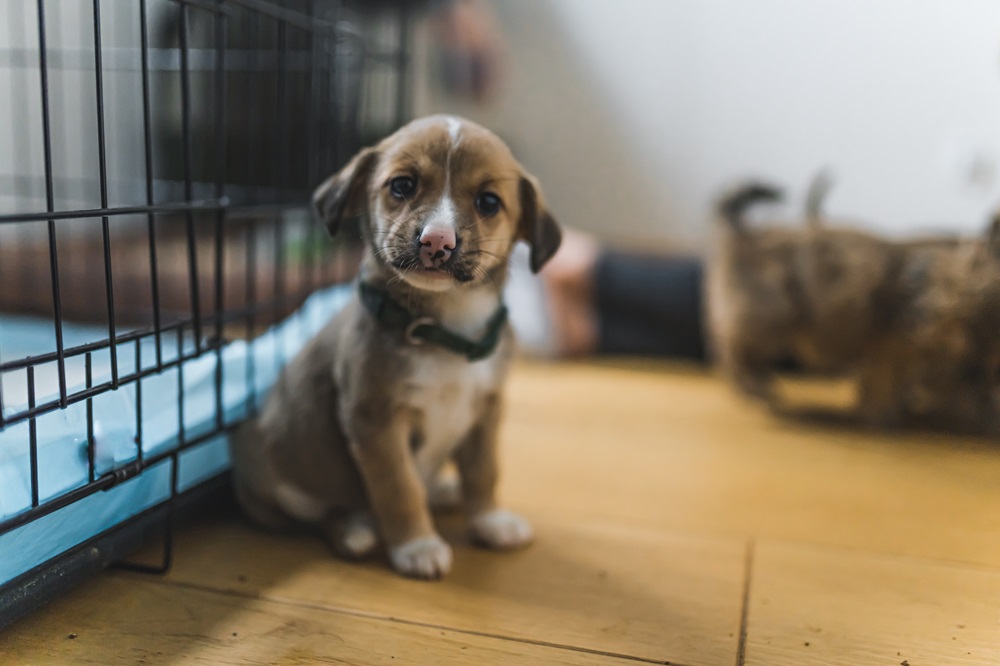Animal Chatter
by Iris Winston
No dog of mine has ever ventured an opinion on being confined to a crate. That’s because I’m so uncomfortable with the idea of crate training that I have never been able to go that route.
 I have heard a long list of the advantages of familiarizing a dog with using a crate. I have seen some dogs head for their crates voluntarily and stay inside even when the door is open. It doesn’t make me feel any less guilty about the thought of keeping one of my beloved animals in such a situation even for a short while.
I have heard a long list of the advantages of familiarizing a dog with using a crate. I have seen some dogs head for their crates voluntarily and stay inside even when the door is open. It doesn’t make me feel any less guilty about the thought of keeping one of my beloved animals in such a situation even for a short while.
I’m not alone in feeling as I do. At worst, crating dogs remains controversial, even illegal in some countries such as Sweden and Finland. In North America, the animal rights organization PETA (People for the Ethical Treatment of Animals) is strongly opposed to crating. On the other side of the coin, a number of humane societies, rescue organizations and dog trainers favour using crates, providing that appropriate care is taken and comfort rules are meticulously observed.
The first rule is that a crate should give a dog room to stand, turn round and stretch out when lying down. The next is that the dog should never be left in a crate, even if it is an appropriate size, for too long. And just how long is too long? Any dog should be exercised immediately before being crated or left. In addition, the appropriate time limit behind bars depends on individual dogs, according to their age, health, tolerance for being confined and how often they need a bathroom break. Certainly, the boundaries should never be stretched beyond any animal’s comfort level, otherwise the next rule—that dogs should learn to regard the crate as a safe place or den—cannot go into effect. Because they should always view the crate positively if crating is to work, it must never be used as a place of punishment. Neither should the crate be placed in a remote corner where the animal is separated from his people unnecessarily.
This is particularly true for a dog with any degree of separation anxiety, who might become so upset that he could injure himself in trying to escape by destroying the crate.

In my view, the risk that the animal may hurt himself or suffer long-term physical or emotional damage is too great. Some dogs, when introduced to crating early and for very short periods, can learn to relax in a crate and may be calm with the arrangement, particularly if it includes comfortable bedding, food, water and toys. Others never overcome the distress of being left in a crate, however well-equipped and correctly sized, while their owner is absent.
As an aside, if one of your reasons for having a dog is to protect you and your home, how is he supposed to do the job from the confines of a crate?
Among the pro-crate training arguments are that the system is a good way to house-train pups because animals do not wish to soil their dens. The thesis works equally well for a bigger space such as using a large exercise pen or sectioning off part of a room until the time comes to take a pup outside and praise him for going when and where you prefer him to eliminate. (Taking a pup out has always made it easier for him to learn what is expected of him than just putting him out.) Confinement for safety when the dog is riding in a car can also be accomplished by a barrier rather than a crate.
As I see the pro-craters, their focus is more on convenience for owners than on looking at the world through a dog’s eyes. While I understand that some dogs grow accustomed to being crated and may actually feel more secure when in a confined space, I believe that a crate should only be used for limited periods in specific circumstances with full recognition of the dog temperament, mood and specific needs.
Even with that, I know that I will never be able to crate any of my dog companions except in such extreme circumstances as air travel—and I would still have to overcome the guilt I felt then.
Almonte, Ontario, writer Iris Winston is a former Executive Director of the Canadian Federation of Humane Societies. She has been an animal lover all her life. Her pets have always been important members of her family.






